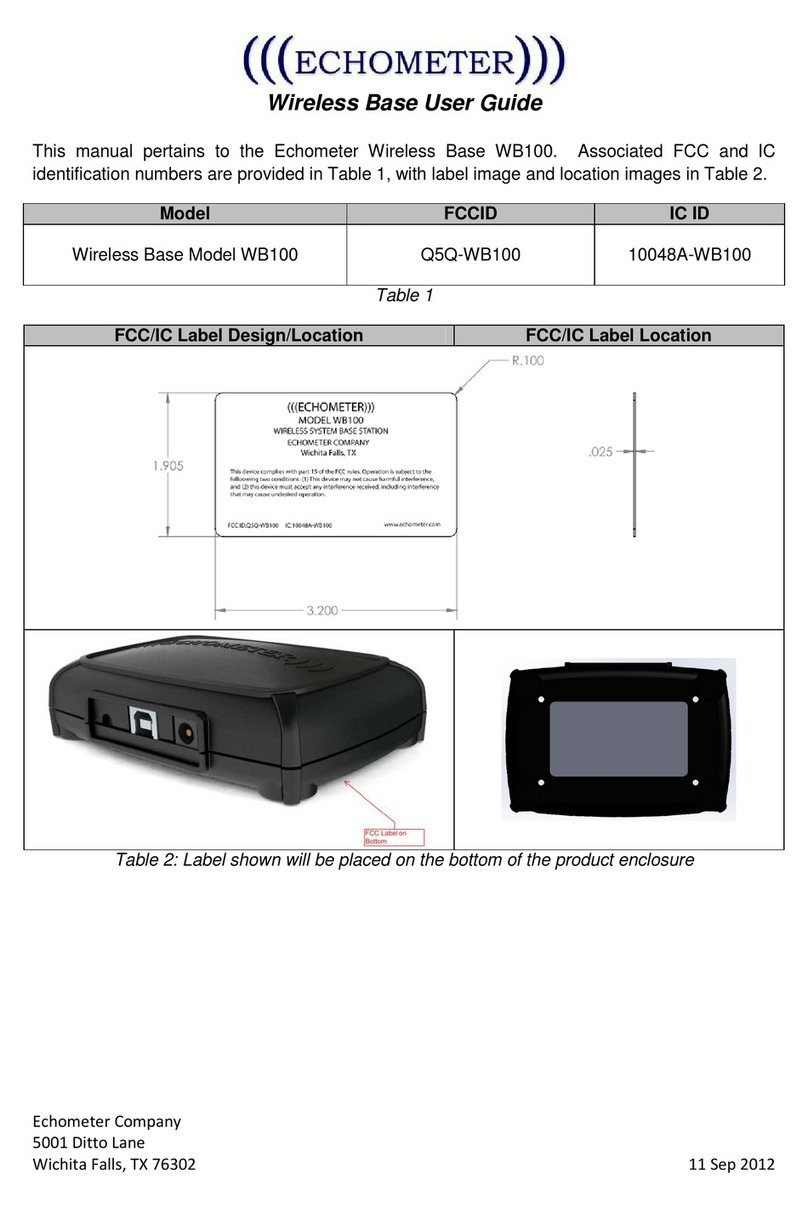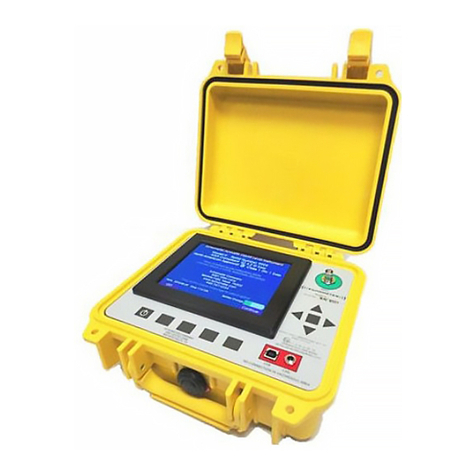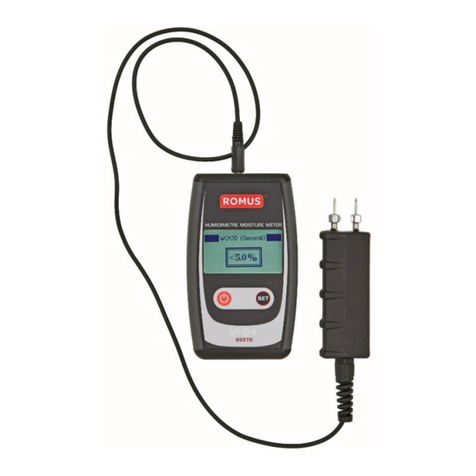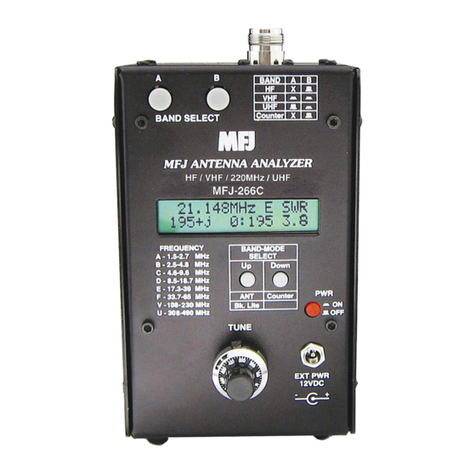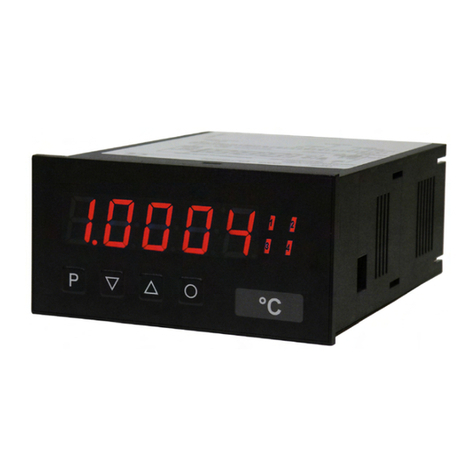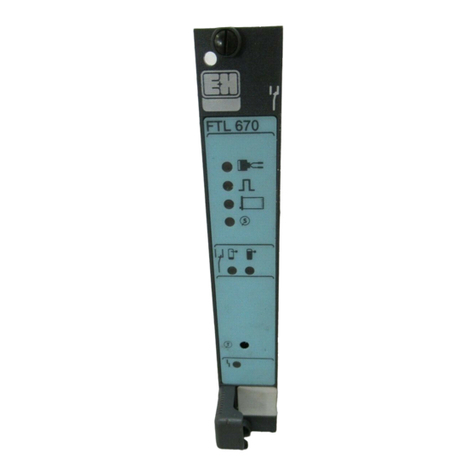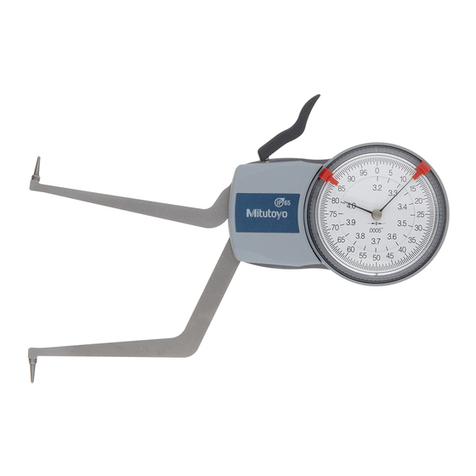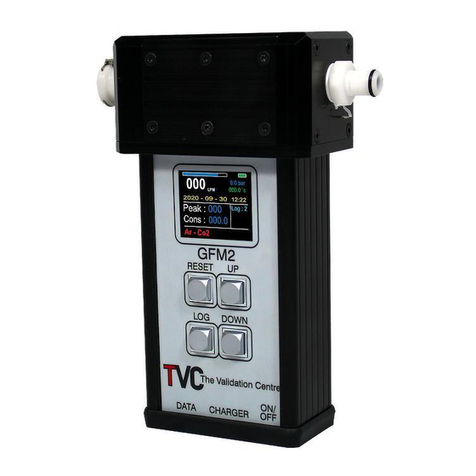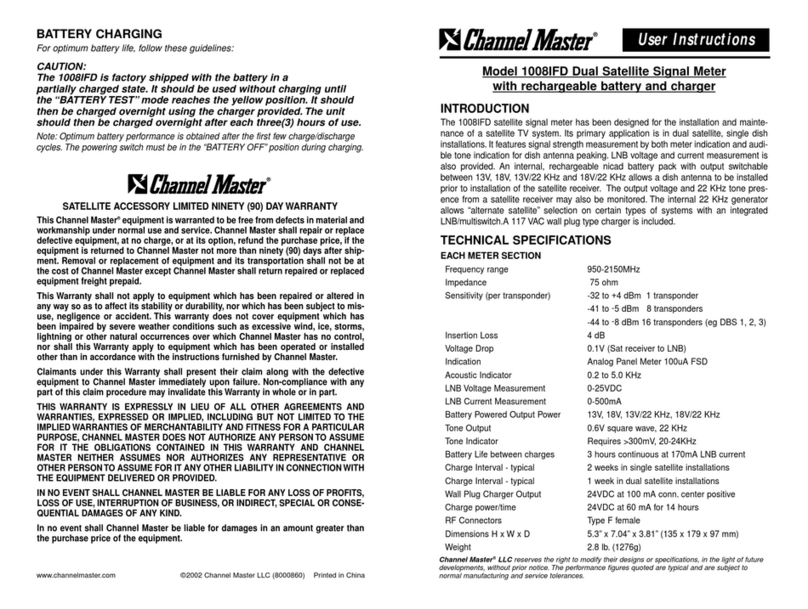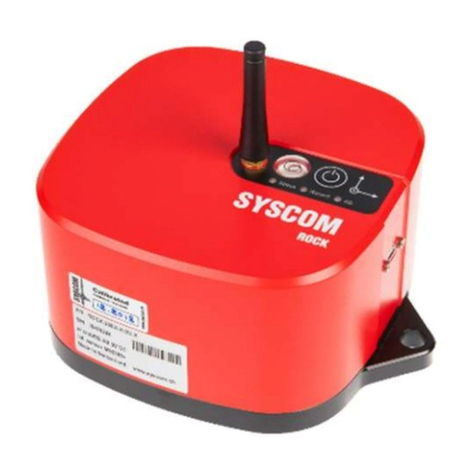Echometer M User manual

Echometer Company Model – M Manual Phone: (940) 767-4334
5001 Ditto Lane Page 1Fax: (940) 723-7507
Wichita Falls, Texas 76302, U.S.A. E-Mail: info@echometer.com
Echometer Model-M
Digital Dual Channel Fluid Level Instrument
Introduction
This operating manual contains information about the Echometer Model M Fluid Level Instrument including operating
procedures, maintenance, shooting problem wells, chart interpretation and technical papers relating to the optimization
of producing wells. Please read the first 25 pages and view the example of the strip chart output forms and charts on
wells before operating the instrument. Additional technical papers can be accessed from the Echometer Web page,
www.echometer.com, these articles offer additional information on the use of acoustic fluid level instruments to
optimize production. Please read these papers at your convenience.
Limits of Liability
Echometer Company reserves the right to revise its software and publications with no obligation of Echometer
Company to notify any person or any organization of such revision. In no event shall Echometer Company be
liable for any loss of profit or any commercial damage, including but not limited to special, consequential, or other
damages.
Information in this document is subject to change without notice and does not represent a commitment on the part
of Echometer Company. The software described in this document is furnished under a license agreement or
nondisclosure agreement. It may be used or copied only in accordance with the terms of the agreement. It is
against the law to copy the software or any medium except specifically allowed in the license or non-disclosure
agreement.
Copyright Notice
Copyright 1997,1998,1999,2000,2001,2002,2003 Echometer Company. All rights reserved. Federal copyright
law protects this manual. No part of this manual may be copied or distributed, transmitted, transcribed, stored in a
retrieval system or translated into any human or computer language, in any form or by any means, electronic,
mechanical, magnetic, manual, photographic, photocopy, scanning, or otherwise, or disclosed to third parties
without the express written permission of Echometer Company.
Trademarks
AWP, TWM, QRod, EchoPUMP, Compact Gas Gun are trademarks of Echometer Company

Echometer Company Model – M Manual Phone: (940) 767-4334
5001 Ditto Lane Page 2Fax: (940) 723-7507
Wichita Falls, Texas 76302, U.S.A. E-Mail: info@echometer.com
Table of Contents
Introduction...............................................................................................................................................1
Limits of Liability..............................................................................................................................1
Copyright Notice................................................................................................................................1
Trademarks.........................................................................................................................................1
Table of Contents......................................................................................................................................2
1 - Safety Considerations..........................................................................................................................4
Echometer Schools.............................................................................................................................4
Additional Information.......................................................................................................................4
2-Principles of Acoustic Measurements...................................................................................................5
Recording and Interpretation of Signals.............................................................................................5
Depth Calculation ..............................................................................................................................6
3 – General Description – Model M.........................................................................................................7
Instrument Panel....................................................................................................................................8
Wellhead Attachments..............................................................................................................................9
Remote Fire Gas Gun.......................................................................................................................11
High Pressure Gas Guns...................................................................................................................12
Accessories..........................................................................................................................................12
Model M Modifications and Enhancements…………………………………………………………13
4 - Operation...........................................................................................................................................15
General Recording Procedure ..........................................................................................................15
Operation of the Model M with the Compact Gas Gun...................................................................16
Operation of the Model M with the Remote Fired Gas Gun............................................................17
Recommendations for Optimum Performance.................................................................................18
Automatic Gain Setting (AGS) Mode Characteristics.....................................................................19
Manual Gain Setting (MGS) Mode Characteristics.........................................................................19
Collar Channel Automatic Gain Control (AGC) .............................................................................19
Liquid Level Channel Gain Control.................................................................................................19
5 - Interpretation .....................................................................................................................................20
6 - Problem Wells...................................................................................................................................21
7 - Battery and External Power Information...........................................................................................22
Important Notes and Instructions for Rechargeable Batteries..........................................................23
8 - Testing/Troubleshooting....................................................................................................................24
Amplifiers Check.............................................................................................................................24
Filters Check ....................................................................................................................................24
Microphone Cable check..................................................................................................................24
Microphone Check...........................................................................................................................24
9 - Maintenance ......................................................................................................................................25
Compact Gas Gun Pressure Rating..................................................................................................25
Compact Gas Gun Disassembly and Assembly Special Precautions...............................................25
Remote Fire Gas Gun Pressure Rating.............................................................................................26
Remote Fire Gas Gun Disassembly and Assembly Special Precautions .........................................26

Echometer Company Model – M Manual Phone: (940) 767-4334
5001 Ditto Lane Page 3Fax: (940) 723-7507
Wichita Falls, Texas 76302, U.S.A. E-Mail: info@echometer.com
10 – Calculation of Bottomhole Pressures..............................................................................................27
11 – APPENDIX.....................................................................................................................................28
FIGURE 1a - COMPACT GAS GUN ASSEMBLY DRAWING..................................................28
FIGURE 1b - REMOTE FIRE GAS GUN ASSEMBLY DRAWING...........................................29
FIGURE 2 - ECHOMETER PANEL..............................................................................................30
FIGURE 3 – INITIAL HEADER AND SYSTEM TEST (SHOWN ½ SCALE)............................30
FIGURE 4 – DATA INFORMATION FORM AND TIME STAMP .............................................30
FIG. 5 – UPPER/LOWER COLLARS ACCENTEDFIG. 6 – PROVE LIQUID LEVEL...............31
FIG. 6 – PROVE LIQUID LEVEL..................................................................................................32
Fig. 7 – WELL WITH LINER .........................................................................................................33
FIG. 8 – RECORDS OF COMPRESSION/RAREFACTION INITIAL PULSEACOUSTIC
RESPONSES FROM DOWNHOLE ANOMALIES.......................................................................34
ACOUSTIC RESPONSES FROM DOWNHOLE ANOMALIES..................................................35
Amplifiers And Filters Test .............................................................................................................35
Amplifiers And Filters Test .............................................................................................................36
MICROPHONE CABLE TEST.......................................................................................................37
Microphone Test..............................................................................................................................38
Rate of Fill-up Graph.......................................................................................................................39
USE OF RATE OF FILL-UP INFORMATION..............................................................................40
CARBON DIOXIDE CYLINDER...................................................................................................41
CARBON DIOXIDE INFORMATION (CO2)................................................................................42
NITROGEN INFORMATION (N2).................................................................................................43
FIG. 9 – CO2 CYLINDER W/ HOSE .............................................................................................44
FIG. 10 –Filler Connector for 7.5 OZ. CO2 CYLINDER................................................................45

Echometer Company Model – M Manual Phone: (940) 767-4334
5001 Ditto Lane Page 4Fax: (940) 723-7507
Wichita Falls, Texas 76302, U.S.A. E-Mail: info@echometer.com
1 - Safety Considerations
Read this manual before operating the equipment.
Please observe all safety rules in operating this equipment. The pressure ratings of the Echometer gas gun and
all fittings, hoses, etc. should always exceed actual well pressure. Because the casing pressure normally increases
during a build-up test, caution should be exercised that the well pressure does not exceed equipment pressure
ratings.
Do not use worn or corroded parts. A used or corroded fitting may not withstand original pressure rating.
All safety precautions cannot be given herein. Please refer to all applicable safety manuals, bulletins, etc.
relating to pressure, metal characteristics, temperature effects, corrosion, wear, electrical properties, gas
properties, etc. before operating this equipment.
The tests should not be undertaken if the operator, the test equipment and the well are not in conditions to
operate safely. This equipment should not be used if the operator is tired, ill or under the influence of alcohol,
drugs or medication.
Echometer Schools
Echometer Company offers schools on the use and applications of this equipment. You are invited to attend free of
charge. A list of the schools, which are taught throughout the United States and Canada, will be sent upon request
or can be viewed at http://www.Echometer.com
Additional Information
Please contact Echometer Company to obtain additional information or to clarify any questions that you may
have in regard to the use of this instrument. The street and mailing address, phone number, fax number and e-mail
address are given on the first page.

Echometer Company Model – M Manual Phone: (940) 767-4334
5001 Ditto Lane Page 5Fax: (940) 723-7507
Wichita Falls, Texas 76302, U.S.A. E-Mail: info@echometer.com
2-Principles of Acoustic Measurements
Acoustic liquid level instruments were developed in the 1930's. An acoustic wellhead attachment is connected to an
opening in the casing annulus at the surface of a well as shown in Figure 1 in the appendix. The acoustic wellhead
attachment consists of an acoustic pulse generator, a microphone and optionally a pressure gage. Throughout the
years, acoustic pulse generators have included a dynamite cap, 45-caliber blank, 10 gauge black powder blank, a
compression gas pulse and a rarefaction gas pulse. The explosive dynamite caps and blanks are a safety hazard and
have resulted in damage to wells and environment. While these explosive sources should not create a problem if the
casing annulus contains only hydrocarbon gas, major explosions have occurred when oxygen was allowed to enter the
casing annulus during work-overs or when special conditions resulted in a vacuum in the casing annulus
The versatility, economy and convenience of gas guns have resulted in widespread use of this type of acoustic pulse
generator. The expansion of gas from a volume chamber into the well generates the acoustic pulse. In most cases,
compressed CO2or N2gas is loaded into the volume chamber, which is charged to a pressure greater than the well
pressure. A valve in the wellhead attachment is opened rapidly, either manually or electrically, resulting in a pressure
pulse being generated in the casing annulus gas. The acoustic pulse travels through the gas in the casing annulus and
is partially reflected by changes in cross sectional area such as tubing collars, tubing anchors, casing perforations, etc.
The remaining pulse energy is then reflected by the gas/liquid interface at the depth of the liquid level. The reflected
signals travel back to the surface of the well where they are detected by the microphone.
The microphone within the wellhead attachment converts the reflected acoustic signal into an electrical signal
consisting of a series of pulses, which correspond to the sequence of reflections. The microphone must operate over
a wide pressure range from a vacuum to the maximum pressure that exists in the wells being tested. The microphone
should be designed to cancel the mechanical vibrations of the wellhead while remaining sensitive to the acoustic
signal reflections.
Recording and Interpretation of Signals
An amplifier/recorder filters and amplifies the electrical signal from the microphone and records the enhanced
signals on a strip chart. Modern instruments use analog to digital converters and microprocessors to improve the
signal quality and print the chart. The frequency content of the reflected acoustic signals varies depending on the
characteristics of the initial pulse, the pressure in the gas, the distance traveled and the type of cross sectional area
change. In general, as the pulse travels in a gas, the amplitude of the signal decays. The high frequency energy
decays more rapidly than the low frequency energy. Thus, the acoustic response from the collars at the top of the
well contains high frequency energy, the response from deep collars contains medium frequency and the signal
from the liquid level is mostly low frequency energy. This is especially apparent in deep wells with low casing
pressure. Fluid level instruments are designed to include various filters, which can be used to accent signals that
correspond to these frequency ranges. The Model M records the signal on the dual channels. One channel is tuned
to higher frequencies from the collars while the second channel is tuned to low frequencies from the liquid level.
Single channel instruments can be operated in any of these modes and it is possible to switch from one frequency
response to another while the instrument is recording. Initially, the single channel instrument is operated in the
collar mode (high or medium frequency), which is then switched to the liquid level mode (low frequency) when the
collar signal fades. Switching may be manual or automatic.

Echometer Company Model – M Manual Phone: (940) 767-4334
5001 Ditto Lane Page 6Fax: (940) 723-7507
Wichita Falls, Texas 76302, U.S.A. E-Mail: info@echometer.com
Depth Calculation
In most cases, once a strip chart record has been obtained and the liquid level signal has been identified, the
operator must count the number of tubing collar reflections from the surface to the liquid level in order to calculate
its depth. The corresponding number of tubing joints, multiplied by the average joint length yields the distance to
the liquid level.
Other techniques are available for determining the liquid level depth. When other signals are identified on the
chart, such as those generated by gas lift mandrels, liner tops, tubing anchors or perforations, the known depth of
these anomalies can be used to calculate the depth to the deeper liquid level by the ratio of chart distance or
elapsed time. When the lengths of tubing joints vary considerably, so that an average joint length is not
representative, some operators placed an over-sized tubing collar (marker) to serve as a depth reference.
When the specific gravity or the composition of the gas in the annulus is known with some accuracy, then the
velocity of sound in the gas can be calculated. The acoustic wave round-trip travel time from the initial pulse to
the liquid level reflection is read directly from the strip chart, which displays timing marks. The round-trip travel
time is divided by two and multiplied by the acoustic velocity to calculate the depth to the liquid level.
Still another technique involves measuring the acoustic velocity of the gas by sampling the casing gun into a tube
of sufficient length to measure the velocity of sound in the gas by pulse testing. This technique is applicable only if
the well continuously vents gas from the annulus so that a representative sample of the gas sample obtained at the
top of the well will not be representative of the gas in the well.
The most common application of an acoustic liquid level instrument is to measure the distance to the liquid level in
the casing annulus of a well. However, it can also be applied to measurements inside tubing. Other applications
include determination of the distance to the mud or kill liquid level during drilling and work-overs. The acoustic
instruments can be used to measure the distance to any change in cross-sectional area inside pipe or in the annulus.

Echometer Company Model – M Manual Phone: (940) 767-4334
5001 Ditto Lane Page 7Fax: (940) 723-7507
Wichita Falls, Texas 76302, U.S.A. E-Mail: info@echometer.com
3 – General Description – Model M
The Echometer Model M is a dual channel, microprocessor controlled amplifier/recorder. It permits better
interpretation of reflections from downhole anomalies since two different filters are used to improve the signal.
Processing and simultaneously recording reflected signal using two separate amplifiers having different frequency
response, improve the ability of the operator to distinguish downhole obstructions from enlargements. The
response from the liquid level (orreduction in annulus area) is opposite to the response from an enlargement such
as a hole in the casing. The Model M uses modern electronics, integrated circuits, chart drive system and a thermal
printhead, which result in a very compact and lightweight system.
The dual channel Model M accents and records collars on one channel, and the liquid level response on a second
channel. The collar channel can be set to record sharp upper collars or deep collars. Selecting the proper collar
filter will result in more accurate determination of the number of tubing collar reflections from the surface to the
liquid level. The lower trace accents the signals from the liquid level, tubing anchor, gas-lift mandrels, casing
perforations and other major anomalies.
A microprocessor is used with an analog to digital converter, memory chip, amplifiers, clock, timing circuit and
other electronic components to improve the performance and utility of the instrument. When an acoustic pulse is
generated in the well, the signals reflected from the collars at the top of the well are large but rapidly attenuate.
The microprocessor is programmed to evaluate the signal level and increase or decrease the collar amplifier gain as
necessary to optimize the quality of the recording. The collar and other signals will be recorded at a width of
approximately 0.6-inch (12-mm), which simplifies the manual counting of the collars since the amplitude of the
collar signal is maintained automatically. The automatic control of the recording level is called automatic gain
control.
The microprocessor is used in conjunction with a timer. Since these instruments are used throughout the world, the
universal coordinated time and date are printed on the strip chart. Also, the timing capabilities of the
microprocessor, clock and timing circuit are used to place labeled markers at one-second intervals beginning from
the instant the acoustic pulse is generated. This allows the operator to determine the round trip travel time very
accurately. The travel time and the distance to the liquid level are used to compute the acoustic velocity of the gas
in the annulus. The acoustic velocity the casing pressure and average temperature can be input to the utility
program AWP for Windows to compute the gas gravity and the pressure distribution in the well, including the
pump intake pressure and the pressure at the perforations.
In addition to recording both collar and liquid level signals simultaneously, the digital printhead generates a
header, an analysis form, and prints the values of background noise, battery voltage and special instructions on the
strip chart.
The entire instrument is contained in a waterproof, dustproof plastic housing having dimensions of 11 by 10 by 5
inches and weighs 11 pounds (5 kg). The following section describes the instrument panel and the function of the
various controls.

Echometer Company Model – M Manual Phone: (940) 767-4334
5001 Ditto Lane Page 8Fax: (940) 723-7507
Wichita Falls, Texas 76302, U.S.A. E-Mail: info@echometer.com
Instrument Panel
The instrument panel is shown schematically in Figure 2 in the appendix. The following controls are used for
operating the instrument and for checking that it is operating correctly:
•Power Switch:
Momentarily placing the switch in the ON position energizes the amplifier, activates a red light that indicates
that the battery is powering the electronics and records a header on the strip chart. The microprocessor
performs a system test and checks the battery voltage. If the battery voltage is low, a message is printed to
charge the battery. If the system is OK, the chart drive stops after printing the battery voltage and test signals
on the collar and liquid level channels, and the message " TURN ON CHART DRIVE TO TEST WELL".
The power can be turned off manually, or the power will automatically turn off after approximately 15 minutes
of non-use.
•Upper Collars/Lower Collars Switch:
This two-position switch selects whether the collar channel is connected to the high frequency (Upper Collars)
or medium frequency (Lower Collars) filter circuits.
•Collars Gain
This knob controls the gain of the collar channel. The most counter-clockwise position (AUTO) activates
automatic gain setting and should be used first always. In the AUTO mode, the gain is set automatically.
Having the gain indicator on a value greater than 1 when the chart drive is turned on allows the operator to
control the amplifier gain by setting the gain control knob as desired before the “shot” is detected. After the
“shot” is detected, the instrument uses the gain setting when the shot is detected and the operator cannot adjust
the gain.
•Liquid Level Gain
This knob controls the gain of the liquid level channel. The most counter-clockwise position (AUTO)
activates automatic gain setting and should be used first always. In the AUTO mode, the gain is set
automatically. Having the gain indicator on a value greater than 1 when the chart drive is turned on allows the
operator to control the amplifier gain by setting the gain control knob as desired before the “shot” is detected.
After the “shot” is detected, the instrument uses the gain setting when the shot is detected and the operator
cannot adjust the knob.
•Chart Drive Switch
This switch is used to turn on and off the chart drive. Turning the switch to ON begins the data acquisition
sequence. This consists of printing the data forms followed by the gain settings and the noise level on both
channels, followed by the statement GENERATE PULSE and the recording of the two channels. The chart
drive continues on until the switch is turned OFF.
•Input Connector
This BNC INPUT connector is the input to the amplifiers. When acquiring data, this INPUT connector must
be connected to the microphone connector on the acoustic wellhead using a good coaxial cable with clean
connectors.
•Remote Fire Connector
Connects the instrument to the solenoid valve of a remote fire gas gun if a remote fire gun is utilized.
•Remote Fire Switch
Depressing this switch operates the solenoid valve on a remote fired gas gun by applying 12 volts to the
solenoid coil. Depress the switch for 1 second to fully release gas from the chamber.

Echometer Company Model – M Manual Phone: (940) 767-4334
5001 Ditto Lane Page 9Fax: (940) 723-7507
Wichita Falls, Texas 76302, U.S.A. E-Mail: info@echometer.com
•Battery Charger Connector
Attaching the 110 VAC or the 220 VAC battery charger or the 12V-car battery power cable to this connector
charges the built-in battery.
•Test Connector and Test Switch (on units serial number 4999 and below only.)
This TEST connector should be attached to the INPUT connector using the coaxial cable in order to check
that the instrument and the coaxial cable are operating correctly. Depressing the test switch applies a test
signal to the input of the amplifier via the TEST connector and the coaxial cable.
•Chart Paper Drive
Pushing the spring-loaded aluminum plate cover towards the right and lifting it from the left side accesses the
chart paper. The paper is dropped into the cavity so that it unrolls counter-clockwise. After inserting the
paper roll, the aluminum cover is replaced. The printed Echometer logo on the paper should face up since
only this side of the paper is heat sensitive. The heat sensitive paper supplied by Echometer Company
operates over a wide temperature range and is made for the Echometer Chart drive system. The chart drive
has a paper sensor to determine when paper exists in the drive. If the sensor detects that paper is not present,
power is not supplied to the printhead. If paper is not present in the drive system and power is supplied to the
printhead, the printhead will be damaged because the small heating elements in the printhead will be
overheated. Using paper that is not of the proper width may result in printhead failure. Use only Echometer
paper to insure proper operation of the printhead and chart drive system.
Wellhead Attachments
Compact Gas Gun
The Compact Gas Gun consists of a microphone and a ten cubic inch volume chamber with a ¼” outlet
valve. The outlet valve will open rapidly when the trigger is pulled. This generates a pressure pulse. If
the pressure is greater in the volume chamber than in the casing annulus, a compression pulse is
generated. If the pressure is greater in the casing annulus than in the volume chamber, a rarefaction
pulse is created. A differential pressure must exist between the volume chamber and the casing annulus
for a pressure pulse to be generated. The operator has the choice of using an explosion or implosion
pulse.
Compression (Explosion) Pulse
Explosion utilizes an external gas supply to generate an acoustic pulse in the well. In the explosion
mode, the volume chamber is charged from an external gas supply to a pressure in excess of the well
pressure. Operating in the explosion mode keeps the inside of the chamber cleaner and results in less
maintenance.
Rarefaction (Implosion) Pulse
If the well’s casing pressure is greater than 200 PSI, implosion can be used. This method uses the
well’s pressure to generate a pulse. Use the gas gun filler/bleed valve to release gas from the volume
chamber. An external gas supply is not necessary to operate in the implosion mode. Operation in this
mode forces sand, moisture and other debris into the gas gun volume chamber and thus requires more
maintenance including frequent replacement of “O” rings.
Description of Compact Gas Gun Control Functions (refer to drawing)

Echometer Company Model – M Manual Phone: (940) 767-4334
5001 Ditto Lane Page 10 Fax: (940) 723-7507
Wichita Falls, Texas 76302, U.S.A. E-Mail: info@echometer.com
Volume Chamber Pressure Gauge
The volume chamber pressure gauge measures the pressure in the gas gun volume chamber. During normal operation, the
volume chamber is charged to 100-psi more than the casing pressure. Use additional pressure if required for satisfactory
results. If the internal gas valve is open, the gauge indicates the pressure between the gas gun and the casing annulus valve.
If the casing annulus valve is open, the gauge indicates the casing pressure.
Casing Pressure Gauge Quick Connector
The quick connector is located on the side of the housing. A precision pressure gage having a range close to the pressure
being measured will fit into the quick connector to enable the operator to obtain the casing pressure and casing pressure
change with sufficient accuracy to perform calculations of producing BHP and casing gas flow rate.
Cocking Arm
The cocking arm is lifted to depress and close the valve between the gas chamber and the casing.
Casing Pressure Bleed Valve
This valve allows bleeding the pressure between the casing valve and the compact gas gun. Turn the knob counter clockwise
to release the pressure. Verify that the casing valve is closed before opening the bleed valve.
Gun Filler-Bleed Valve
The filler-bleed valve is used to pressurize the gas gun volume chamber or to remove gas from the gas gun volume chamber.
Gas is added to the chamber from a pressurized external gas source by insertion of mating quick connector, into the filler &
bleed valve. Gas is bled from the chamber by rotating the knob clockwise. This action depresses the internal valve core
and releases the gas from the volume chamber to the atmosphere.
Trigger Pawl
The Trigger Pawl is pulled to release the gas valve between the gas gun volume chamber and the casing. If sufficient
pressure exists in the volume chamber or on the end of the gas valve, the gas valve will open.
Microphone
The microphone is a twin-disc pressure sensitive device that is vibration canceling.

Echometer Company Model – M Manual Phone: (940) 767-4334
5001 Ditto Lane Page 11 Fax: (940) 723-7507
Wichita Falls, Texas 76302, U.S.A. E-Mail: info@echometer.com
Remote Fire Gas Gun
The remotely fired gas gun generates an acoustic pulse and detects the downhole reflections. The gas gun contains
a volume chamber, which is filled with compressed gas to deliver the acoustic pulse to the well. A microphone
housed in the gas gun detects the shot, collars and other wellbore reflections, and liquid level. The standard unit
has a working pressure of 1500 PSI.
Gas Valve and Solenoid
The solenoid serves as a trigger mechanism to initiate the acoustic pulse. When energized, the solenoid lifts a small
plunger and allows gas pressure to bleed off the top of the gas valve. Gas pressure then forces the gas valve open, causing
an acoustic pulse to be delivered to the well as the gas flows from the volume chamber into the well, (see the remote fire
gun diagram.) The gas valve does not hold pressure from the well. Therefore, gas pressure must be applied to the volume
chamber inlet port in order to close it. Whenever the valve is left open, well fluids will flow backwards through the gun
and into the volume chamber. This flow may entrain sand and other debris. These deposits may prevent the gas gun from
operating properly. To minimize this potential problem, it is advisable to charge the volume chamber with clean gas
before the casing valve is opened and as soon as the strip chart from any shot has been recorded. This will prevent the
well fluids and debris from entering the solenoid gas valve mechanism and causing a malfunction of the firing mechanism.
Volume Chamber Pressure Gauge
The volume chamber pressure gauge measures the pressure in the gas gun volume chamber. It should be used to
determine if the chamber pressure is sufficiently high (explosion mode) to generate the acoustic pulse. The volume
chamber pressure should be approximately 100-psi in excess of casing pressure unless additional pressure is required to
obtain desire results.

Echometer Company Model – M Manual Phone: (940) 767-4334
5001 Ditto Lane Page 12 Fax: (940) 723-7507
Wichita Falls, Texas 76302, U.S.A. E-Mail: info@echometer.com
Casing Pressure Gauge or Optional Transducer
The casing pressure and casing pressure buildup during the acoustic test must be measured with an accurate and sensitive
pressure gauge or sensor. The Remote Fire Gas Gun supplied with the Echometer Model M is equipped with a quick
connect gauge that covers the range 0-200 psig. The user should consider the option of obtaining several gauges
covering different pressure ranges.
Charging the Gas Volume Chamber
To charge the volume chamber, first connect the filler adapter to a 7.5 oz. CO2bottle. Then, press the adapter against
the filler fitting on the gun. When these two fittings are pressed together, a valve core in the bottle is depressed and gas
will flow from the bottle into the volume chamber. Charge the chamber to at least 100 PSI above casing pressure before
attaching the gas gun to the casing annulus valve to prevent debris from entering the gas gun internal valve parts. The
volume chamber pressure can be read on the gun-mounted gauge. A 5-LB, CO2bottle and hose with connector can be
used to change the gun, if desired.
High Pressure Gas Guns
The 5000-psi gas gun is normally used in the implosion mode. It has an excellent noise-canceling microphone and
generates a very good pulse when the 1/2-inch ball valve is opened rapidly and the well pressure exceeds 200-psi. When
the 5000-psi gas gun becomes dirty due to debris imploding from the wellbore, the volume chamber and the microphone
assembly can be easily flushed with a solvent. The 5000-psi gas gun requires very little maintenance. It is excellent for
gas lift, flowing and high-pressure shut-in wells. It can be used in the explosion mode by charging the gas gun volume
chamber to a pressure in excess of the well pressure.
The 15000-psi High Pressure Gas Gun operates in the implosion mode only. Excellent results have been obtained at
pressures above 1500-psi through needle valves with 1/8-inch orifices, which are standard in most high-pressure wells.
For more details please refer to the Gun-Microphone Assemblies brochure in the appendix.
Accessories
Battery Charger (110 V- AC) or (220 V - AC if requested)
Automobile Battery Cable
Automobile Cigarette Lighter Cable
Casing Pressure Gauges
Precision Test Gauge
Precision Digital Gauge
Gas Cylinders
2-1/2 LB CO2
5 LB CO2
Nitrogen Cylinder

Echometer Company Model – M Manual Phone: (940) 767-4334
5001 Ditto Lane Page 13 Fax: (940) 723-7507
Wichita Falls, Texas 76302, U.S.A. E-Mail: info@echometer.com
Model M Modifications and Enhancements
The following changes have been made to improve the Model M performance and versatility starting with serial
number 5100. 1) The year, date and local time can be printed on each chart. 2) A chart operation delay switch
“ARM” has been added to allow the operator to “ARM” the Recorder and then walk over to the gas gun and fire the
shot before the chart drive starts to record data. The chart will record one second of acoustic data before the shot, then
record the shot and then the reflected acoustic data. 3) The well performance analysis header can be printed or not
printed on the strip chart. Other internal electronic features have been added in addition to these operating features.
The new panel, the information header and the well analysis header are shown below.
1. Year, Date and Time Setting The Enhanced Model M has provisions for setting year, date and local time in the
field. Previous units were set at Echometer Company factory for Universal Coordinated Time at Greenwich,
England. Thus, each operator had to determine from the universal time setting what time that the chart was
obtained at his particular location if he was outside of the Universal Coordinated Time Zone in England. The date
and time on the enhanced Model M are set as follows. There are two small holes located in the lower panel to the
left of the input connector. See picture on the next page. A small probe such as a straightened paper clip is
inserted into either hole to depress either of two switches below the panel. To set the year, month, date and time,
depress and hold down the switch below the left hole and turn the amplifier POWER switch ON. The instrument
will enter the Date/Time setting mode and will print instrument information including the current year, month, date,
and time. Pressing the switch below the left hole with the paper clip will decrement the year and pressing the
switch below the right hole will increment the year. The number of times that the switch is depressed controls the
amount of change. Turning the chart switch from OFF to ON to OFF will reprint the selected year. Again, the
year can be changed by depressing the switches below the left or right holes. Turning the chart switch from OFF to
ON to OFF without depressing either the left or right switches will advance the settings mode to the next unit (year,
month, day, hour, minute). Turning the Amplifier switch “Off” will exit the setting mode.
2. “ARM” Delay Start Function The Enhanced Model M has a new mode of operation that has been added to
facilitate operation in normal or hazardous environments with a one-person crew. The Model M chart drive will
not be actuated until the gas gun initial pulse is generated and the electronics senses the gas gun initial pulse.
When the “ARM” button is depressed and held down while the chart drive is turned on, and the chart drive will not
run until the electronics senses the large initial gas gun pressure pulse. The chart drive will not activate when the
chart drive switch is turned on. A data delay memory system is present in the Model M electronics that saves data
for later printing. When the shot is detected by the electronics, the chart will be started and the header will be
printed followed by the delayed acoustic data beginning with the last second of acoustic background noise before
the shot was detected. Then, the Model M prints acoustic data of the initial pulse and the reflected acoustic signal
until the chart drive is switched “Off” or 30 seconds maximum. Auto and manual gains are operational but
response is delayed by the memory system. IMPORTANT: wait at least 5 seconds after the “ARM” button is
depressed while the chart drive is switched on for the system to measure background noise before actuating the gas
gun pulse. When using CSA and ATEX certified equipment, the Model M is to be 25’ from the well in a “safe”
area and connected by a single coaxial cable to the Certified Compact Gas Gun or Certified 5000 Psi Gas Gun.
3. Chart Header The chart header is supplied from the Echometer factory with the following information showing
instrument identification and also the second insert below showing well analysis. A switch on the processor circuit
board permits selection of just the first header if desired. This header shows the ID, Version of software in the unit,
Serial Number and other information. The header also shows the POWER ON/SELF TEST and immediately
below, indicates whether the unit did PASS or FAIL the self test. Thus, the external test connector and the test
pushbutton on earlier units have been eliminated. Please refer to the sample chart shown below for an example of a
PASS test. Immediately below the self test, the Battery voltage is displayed. The unit can be charged every night
without damaging the battery using the supplied Echometer AC charger; or, the unit can be charged when the
battery voltage drops to 11.5 volts.

Echometer Company Model – M Manual Phone: (940) 767-4334
5001 Ditto Lane Page 14 Fax: (940) 723-7507
Wichita Falls, Texas 76302, U.S.A. E-Mail: info@echometer.com
The special chart insert that follows the initial heading above allows the operator to indicate the producing rate
efficiency and maximum production rate by hand input of the casing pressure and casing pressure build up rate
along with other information to perform a well analysis that is hand written onto the chart itself. The software
program “Analyzing Well Performance 2000” (for calculating the production rate efficiency and maximum
production rate) can be downloaded from www.echometer.com. Contact John Ryan at 940-767-4334 Ext 22 or
email John@echometer.com for written instructions if you desire to delete the following from the chart header.
Remote Fire Gas Gun When both collar and liquid level gain controls are set to the “AUTO” position, the
Model M will automatically provide a fire signal to the Remote Fire Gas Gun after the chart drive is turned ON.
When manual gain settings are used, the FIRE pushbutton is used to provide a fire signal to the Remote Fire Gas
Gun. The recorder must be connected to the Remote Fire Gas Gun solenoid by the proper Echometer cable.
Year, Month, Date and Time
Adjustment Access Holes
ARM Switch
Amplifier Power Switch

Echometer Company Model – M Manual Phone: (940) 767-4334
5001 Ditto Lane Page 15 Fax: (940) 723-7507
Wichita Falls, Texas 76302, U.S.A. E-Mail: info@echometer.com
4 - Operation
Operation of the instrument is simple. First the acoustic wellhead should be attached to the casing annulus valve,
and the cable connected between the microphone and the instrument. The valve between the casing annulus and the
flow line should be closed to prevent the casing annulus gas from venting into the flow line causing excessive
noise.
General Recording Procedure
When the power switch is turned on, a red LED light indicates that the battery is powering the electronics. The
chart drive turns on and a header is printed as shown in Figure 3 in the appendix. Next, a system test is performed
which also displays the battery voltage. If the battery voltage is low, a message to charge the battery is displayed.
Then, the message is printed to "Turn on the chart drive to test well" and the chart drive stops until the chart drive
switch is turned to the ON position. At this point the operator selects the type of collar response (filter) desired.
Sharp upper collars can be selected for special applications such as shallow wells, irregular tubing length, dual
tubing strings and other special applications. The lower collar position is selected for most deep wells especially
with low casing pressure. Normally, both gain controls are set to the AUTO position and only changes from these
settings are necessary for those cases when satisfactory recordings are not obtained in the automatic position. When
the chart drive is activated, the form shown in Figure 4 is printed on the strip chart. This form is designed to insure
that the operator will write all the pertinent information about the well and the test. This includes the well
designation, the casing pressure, the casing pressure buildup rate and the latest well production test results. The
universal coordinated time stamp is beneficial for tracking the sequence of shots and calculating the exact time
interval between shots. The time interval is necessary when calculating rate of change in liquid level from which
can be computed the well influx (or injectivity) rates or to compute pressure buildup rates. Next, the acoustic
analysis form is printed on the strip chart. During the time that the forms are being recorded on the strip chart, the
instrument measures the background noise on both channels and then analyzes the noise in terms of peak to peak
amplitude and records the AUTO position when the chart drive is turned on, later adjustment of the gain control
does not affect amplifier gain. Then, a message to generate the pulse is printed on the strip chart. When the shot is
generated, the instrument detects the large signal and prints a vertical dotted line to mark zero time on the chart.
Each second thereafter another mark is recorded and labeled with the corresponding elapsed time in seconds. If
the “shot” is not detected by the electronics (which is indicated by the zero time mark), a larger pulse must be
generated so that the electronics will detect the initial pulse. After the zero time mark is printed on the chart,
operator adjustments of the gain control do not affect amplifier gain. This prevents the operator from increasing
the gain, which might result in noise being mistaken for a liquid level kick. The operator turns off the chart drive
after the liquid level response and other desired information is observed on the chart. The acoustic liquid level test
can be repeated by reloading the gas chamber, turning on the chart drive, and generating another acoustic pulse. If
the operator desires to manually select the amplifier gain, the gain control knob must be set at a value greater than
one before the chart drive is turned on. The collar channel gain should be set so that the response is approximately
1/8 inch (3 mm) before the shot. The liquid level channel gain should be set so that the response is 1/16 inch (1
mm) before the shot. Operator adjustment of the gain control after the “shot” is detected and the zero time mark is
recorded does not affect amplifier gain. If the recording level is excessive from downhole anomalies such as a
tubing anchor or perforations, a lower gain setting should be used. Both channels may be set in AUTO gain setting
mode or both in manual gain mode or one channel may operate in manual while the other is set to AUTO. Figure 5
shows two records. The upper record is with the filter setting on upper collars and the lower record shows the
response when the filter setting is lower collars.

Echometer Company Model – M Manual Phone: (940) 767-4334
5001 Ditto Lane Page 16 Fax: (940) 723-7507
Wichita Falls, Texas 76302, U.S.A. E-Mail: info@echometer.com
Operation of the Model M with the Compact Gas Gun
The compact gas gun is to be operated in the COMPRESSION (Explosion) or RAREFACTION (Implosion) mode. The
operator should use the Compression (explosion) technique when the casing pressure is less than approximately 100 psig.
The Rarefaction (implosion) technique may be used whenever the casing pressure is sufficient to obtain a good record.
COMPRESSION (EXPLOSION) MODE
Expansion of gas from the Echometer gas gun is used to generate a pressure pulse. The pressure pulse is positive since the
gas chamber is charged to a pressure that exceeds the well pressure by at least 100-psi.
1. Securely attach the Echometer Gas Gun to the Casing Valve.
2. Close the Casing Pressure Bleed Valve and Filler Bleed Chamber Valve.
3. Lift the Cocking Arm to close the internal gas valve. This prevents debris from entering the volume chamber.
4. Open the Casing Valve to the Echometer Gas Gun slowly and Close the casing valve to the flow line.
5. Measure the Casing Pressure using the precision pressure gauge.
6. Record Time and Casing pressure.
7. Fill the volume chamber with gas (CO2 or N2) to at least 100-psi in excess of the Casing Pressure.
8. Connect the coaxial cable from the microphone to the Input of the Model M.
9. Turn Power Switch to ON.
10. Select the type of collar response desired and set the gain controls to AUTO.
11. Turn chart drive ON.
12. Generate pressure pulse by pulling Trigger Ring, after “Generate Pulse” is displayed on chart.
13. Turn chart drive OFF after detecting the liquid level signal.
14. Inspect the record and repeat the shot if the signal quality is not satisfactory.
15. Turn power switch to OFF after operation.
16. Record Time and Casing Pressure.
17. Close the Casing Valve between Echometer Gas Gun and the well.
18. Open the Casing Pressure Bleed Valve and release the pressure.
19. Open the Casing Valve to the flow line.
20. Remove the Echometer Gas Gun from the casing valve.
RAREFACTION (IMPLOSION) MODE
Gas is released from the well into the gas gun volume chamber to generate the initial pulse. Debris, moisture, corrosive
liquids and chemicals, and other foreign material may be imploded into the gas gun volume chamber, which will increase
maintenance requirements and may cause corrosion on the inside of the volume chamber.
1. Securely attach the Echometer Gas Gun to the Casing Valve.
2. Close the Casing Pressure Bleed Valve and Filler Bleed Chamber Valve.
3. Open the Casing Valve to the Echometer Gas Gun slowly and Close the casing valve to the flow line.
4. Pull Trigger Ring.
5. Lift the Cocking Arm to close the internal gas valve.
6. Measure the Casing Pressure using the precision pressure gauge.
7. Record Time and Casing Pressure.
8. Bleed the gas chamber pressure through the Filler-Bleeder Chamber Valve by rotating the knob clockwise until the
gas gun pressure has decreased to approximately 200-psi below the casing pressure reading. Use greater or less
differential pressure depending on the quality of the recording.
9. Connect the coaxial cable from the microphone to the INPUT of the Model M.
10. Turn Power Switch to ON.
11. Select the type of collar response desired and set the gain controls to AUTO.
12. Turn chart drive ON.
13. Generate pressure pulse by pulling Trigger Ring, after “Generate Pulse” is displayed on chart.
14. Turn chart drive OFF after detecting the liquid level signal.
15. Inspect the record and repeat the shot if the signal quality is not satisfactory.

Echometer Company Model – M Manual Phone: (940) 767-4334
5001 Ditto Lane Page 17 Fax: (940) 723-7507
Wichita Falls, Texas 76302, U.S.A. E-Mail: info@echometer.com
16. Turn power switch to OFF after operation.
17. Record Time and Casing Pressure.
18. Close the Casing Valve between Echometer Gas Gun and the well.
19. Open the Casing Pressure Bleed Valve and release the pressure.
20. Open the Casing Valve to the flow line.
21. Remove the Echometer Gas Gun from the casing valve.
Operation of the Model M with the Remote Fired Gas Gun
The main differences in operating procedure are that the Remote Fired Gas Gun initial pulse is generated by
depressing the Remote Fire Button on the control panel, and that this gun can only be used in the Compression
(Explosion) Mode.
1. Securely attach the Echometer Remote Fire Gas Gun to the Casing Valve.
2. Charge the gas chamber to at least 100-psi in excess of the estimated well pressure to prevent debris from
entering the volume chamber and the solenoid dart valve assembly.
3. Close the gas gun's Casing Pressure Bleed Valve.
4. Open the Casing Valve to the Remote Fire Gas Gun slowly.
5. Close the casing valve to the flow line.
6. Measure the casing pressure using the precision pressure gauge.
7. Record Time and Casing Pressure
8. Verify that the volume chamber pressure is at least 100-psi in excess of the Casing Pressure.
9. Connect the coaxial cable from the microphone to the Input of the Model M.
10. Connect the remote fire cable from the gun to the REMOTE FIRE connector.
11. Turn Power Switch to ON.
12. Select the collar FILTER and set the gain controls to AUTO.
13. Turn chart drive ON.
14. Generate pressure pulse by depressing the Remote Fire button for approximately one second to insure full
opening of the solenoid valve.
15. Turn chart drive OFF after detecting the liquid level signal.
16. Inspect the record and repeat the shot if the signal quality is not satisfactory
17. Turn power switch to OFF after operation.
18. Record Time and Casing Pressure.
19. Close Casing Valve to the Remote Fire Gas Gun.
20. Open the Casing Pressure Bleed Valve and release the pressure.
21. Open the Casing Valve to the flow line.
22. Disconnect cables and remove the Echometer Gas Gun from the casing valve.
NOTES
1. On deep, low pressure wells; first select the lower collar position.
2. If the initial pulse is not detected which is indicated by the zero timing mark, use a larger initial pulse.
3. If the liquid level is not detected (especially in deep wells with low casing pressure), the volume chamber
pressure should be increased in increments of 300-psi up to the limit of the available gas supply.
4. Do not use a larger volume chamber pressure than needed. Operating the gas gun at 300-psi requires twice as
much gas as when operating at 150-psi. Only one half as many shots will be obtained from a gas cylinder.
5. When using CO2gas above 300-psi (at normal temperatures), liquid may form in the gas gun, which will result
in considerably more gas being used per shot.
6. When using nitrogen gas, use a regulator so that the pressure will not exceed the working pressure rating of
1500-psi.

Echometer Company Model – M Manual Phone: (940) 767-4334
5001 Ditto Lane Page 18 Fax: (940) 723-7507
Wichita Falls, Texas 76302, U.S.A. E-Mail: info@echometer.com
Recommendations for Optimum Performance
The Echometer wellhead should be as near as possible to the casing annulus (or the tubing) preferably within 5
feet. Short (5-10 ft) lengths of pipe can mask the desired downhole signals. Longer (20-60 ft) lengths will generate
multiple reflections, which are hard to distinguish from collar reflections. Use a minimum of 900ells and tees and
direct the blast straight into the well if possible. Two-inch connections are recommended, but one inch
connections are generally satisfactory if the length of 1 inch pipe is kept to a minimum.
Proper sensitivity setting is very important. Select the AUTO gain setting for the first shot. The background noise
level is indicated on the chart. Surface vibrations, leaking gas connections, gas “popping” out of the gas/liquid
interface and other unstable conditions, cause this noise. This background noise is not a part of the signals when
the pressure wave is generated. The instrument will automatically record the background noise at a low level and
larger collar and liquid level signals will be recorded at larger amplitudes, which simplifies the interpretation of the
chart. When operating in the AUTO mode, adjusting the sensitivity after the chart drive is tuned ON does not
change the automatic gain selection made by the electronics and software.
The pressure pulse travels down the well and is reflected by tubing collars and the liquid level. The signals from
upper collar reflections are strong, but the collar response becomes weaker as the pressure pulse travels long
distances to the bottom of the well so that the reflections from the lower collars may be weaker than the
background noise. The liquid level reflection varies from a strong signal in a shallow high pressure well to a very
weak signal in a deep low pressure well. Only signals stronger than the background noise are meaningful in the
recording. It is obvious that strong background noises must be reduced if the recording of lower collars and liquid
level is to be obtained.
Background noise can be classified as surface mechanical vibration noise or acoustic noise. The source of noise
can be determined easily by increasing the sensitivity until signal deflection is obtained. Closing the casing valve
between the microphone and the annulus will cause a reduction in the noise level if its source is acoustic noise. If
the signal level remains the same, then the noise is caused either by surface vibrations or by gas leakage from
extraneous lines connected on the same side of the closed casing valve as the microphone. The microphone is
shock mounted, but if the wellhead attachment vibrates excessively, unwanted signals are generated. Wellhead
vibration result from running gas engines, chattering check valves and other reciprocating surface equipment. It
may be necessary to eliminate wellhead vibrations to obtain better quality records in deep low-pressure wells. All
other lines leading to the casing annulus should be closed.
The main source of down-hole acoustic noise is gas "popping" out of a gaseous annular liquid column or liquid
falling into the wellbore. Downhole noise can also result from tubing and casing leaks. Generally, the down-hole
acoustic noise can be reduced in relation to the desired reflected signals by causing an increase in the casing
pressure. In order to do this, continue to pump the well with the casing vent valve closed. At low pressures, an
increase of 10-psi in the casing pressure almost always improves the record and it only depresses the liquid level by
30 feet.
If the signal from the liquid level is not detected due to excessive surface vibration noise or down-hole acoustic
noise, a larger signal from the liquid level can be obtained by generating a larger initial pressure pulse. Also,
increasing the sensitivity so that the background noise level exceeds 1/8 inch, generally will make interpretation
much more difficult and is not recommended.

Echometer Company Model – M Manual Phone: (940) 767-4334
5001 Ditto Lane Page 19 Fax: (940) 723-7507
Wichita Falls, Texas 76302, U.S.A. E-Mail: info@echometer.com
Automatic Gain Setting (AGS) Mode Characteristics
The Echometer Model M uses a microprocessor, which is programmed to evaluate the signal level before the shot
and set the amplifier gain as necessary to optimize the quality of the recording. The AGS mode on either or both
channels is activated by selecting the AUTO position before the chart drive is turned ON. Both channels are
normally operated in the AUTO mode. Changing the gain control setting from AUTO after the chart drive is
turned ON will not affect the amplifier gain. In both channels, the AUTO mode detects the noise level in the well
and adjusts the GAIN SETTING of both amplifiers so that the noise signal is recorded at a width of 1/8inch on the
collar channel and 1/16 inch on the liquid level channel. The noise level in mV peak-to -peak and the gain settings
(such as A: 7.1) is printed on the header just before the legend "GENERATE PULSE" is printed. The "A:"
signifies the system was in the AUTO gain setting mode and the "7.1" indicates the gain setting.
Manual Gain Setting (MGS) Mode Characteristics
MANUAL gain setting mode is selected by locating the gain control knob to a value greater than 1 before the chart
drive is turned ON. When the acoustic traces are displayed, adjust the gain on the collar channel until 1/8-inch
response is obtained. Adjust the liquid level channel gain control until 1/16-inch response is obtained. Lower gain
settings may be beneficial when the traces are over-driven. Higher settings on the liquid level channel, so that the
background noise is 1/8-inch, may be beneficial if the liquid level response is weak. The gain controls should not be
adjusted after the initial pulse is generated. Both channels can be set to manual mode, or either channel can
operate in manual mode while the other channel is in AUTO mode, or both channels can be set to AUTO mode.
Collar Channel Automatic Gain Control (AGC)
The gain of the COLLAR channel amplifier is automatically controlled so that the signal level is maintained at
0.6 inch peak to peak until the amplifier gain is increased to the setting that results in the background noise being
recorded at an amplitude of 1/8-inch. This results in a record showing collars at an amplitude of 0.6 inch when
strong collar signals are received. When the collar signal level fades to the background noise level or less, the
collar trace and noise will be recorded at 1/8-inch, which indicates to the operator that collars are no longer
distinguishable on the trace.
Liquid Level Channel Gain Control
When operating in the AGS mode, that is, the liquid level gain control is in the AUTO position before the chart
drive is turned ON, the LIQUID LEVEL channel amplifier gain is kept fixed at the setting that is established
automatically by measurement of background noise prior to the shot. AGC is not used. For large, reflected
signals after the shot, the liquid level channel recording will show that these peaks and valleys are clipped. This
method will insure that even low amplitude reflections caused by minor changes in cross section of the annulus (or
tubing) as well as the liquid level signal from deep low-pressure wells will be detected as long as their amplitude
exceeds the noise level. Adjusting the liquid level gain control after the chart drive is turned ON will not affect the
amplifier gain in the AUTO mode.
When operating in the MGS mode, that is, the liquid level gain is set greater than 1 before the chart drive is turned
ON, the liquid level gain control should be manually set so that the noise response is 1/16-inch before the shot. The
gain control knob controls the gain. AGC is not used. On deep low-pressure wells, the manual gain control can be
set so that the background noise is recorded at 1/8-inch before the shot is desired. If reflections from downhole
anomalies are excessive, use a lower gain setting. In manual gain mode, the proper gain should be set before the
initial pulse is detected by the electronics, which is indicated by the zero timing mark. When the initial pulse is
detected, the electronics maintains the gain setting selected by the operator at the time of the pulse detection, and
does not permit an increase in gain by the operator, which could result in the background noise being amplified and
mistaken for the liquid level.

Echometer Company Model – M Manual Phone: (940) 767-4334
5001 Ditto Lane Page 20 Fax: (940) 723-7507
Wichita Falls, Texas 76302, U.S.A. E-Mail: info@echometer.com
5 - Interpretation
In an average well, the following events will be recorded on the chart: a kick will show the initial blast. A series of
small kicks will indicate the tubing collars and then the liquid level kick will be recorded. If the chart is allowed to
continue to run, another kick will often occur after the liquid level kick at twice the time of the first reflected liquid
level kick. This is a signal that corresponds to the pulse traveling from the gun to the liquid level and then to the
surface where it is reflected by the wellhead back down the well and is again reflected by the liquid interface back
to the surface. In shallow and in high pressure wells there may be numerous other reflections from the liquid level.
These are known as "multiples" of the pulse. Since all these signals have traveled the same distance at the same
speed the distance (time) from the initial blast to the first liquid level reflection will be equal to the distance (time)
between the first liquid level kick and the second reflected level kick. Multiple liquid level reflections on very
shallow liquid levels, which are 20 to 60 ft from the surface, can be misinterpreted as collar reflections.
The normal chart has a kick at the start of the trace which corresponds to the initial pressure pulse, a series of small
evenly spaced kicks indicating the collar signals and a large kick indicating the liquid level. On some charts the
collars can be distinguished from the beginning of the chart to the liquid level signal and all the collars can be
counted. The most accurate procedure is to use the eleven point dividers and to mark off groups of ten collars
directly on the chart. On other charts the collars cannot be distinguished clearly all the way from the beginning to
the liquid level reflection. In these cases it may be convenient to repeat the test trying to improve the signal to noise
ratio so as to be able to count a large percentage (better than 60%) of the collars in the well. In these cases it is
necessary to count the collars to the last discernible collar reflection signal and then extrapolate the count to the
liquid level, using the eleven point dividers set on the last collar spacing. The total number of collars counted
multiplied by the average tubing joint length results in the depth to the liquid level. This assumes that the range of
tubing joints is similar for all tubing in the well. This procedure may not be used if there are significant differences
in the lengths of tubing joints. Alternative methods to determine the depth to the fluid level are discussed in the
following section.
On both channels, the direction of kick indicates enlargements and reductions in the cross sectional area of the
annulus (or internal diameter of pipe if shooting down tubing). For an explosion signal, objects which reduce the
cross sectional area of the annulus result in compression reflections and are recorded as downward kicks when the
top of the chart is at the left of the operator. Such objects would be liners, tubing anchors, paraffin deposits or the
liquid level. Conditions that increase the area of the annulus result in rarefaction reflected waves and are recorded
as upward kicks. Such conditions include perforations, "shot" holes, parted casing, parted tubing and the end of the
tubing casing annulus. If an implosion pulse is used, then the responses will be reversed from those of an explosion
pulse.
Please refer to the appendix where several examples of traces corresponding to various wells and different cases of
signals are presented.
For the explosion pulse the liquid level is recorded as a downward kick. If the liquid level is 20 feet or so in a
"shot" hole, then the signal would first deflect upwards, then down as the sound wave is reflected from the liquid
level. Recording the liquid level below a liner will show a downward kick at the liner and a downward kick at the
liquid level then an upward kick if the recorder is still running. The upward kick corresponds to the signal
generated at the liner by the wave which was reflected at the liquid level and which is returning to the surface.
When the wave passes from the narrow liner to the larger casing a portion of the wave is converted to a rarefaction
pulse, which then travels down to the liquid level and then to the surface where it is recorded.
Table of contents
Other Echometer Measuring Instrument manuals
Popular Measuring Instrument manuals by other brands
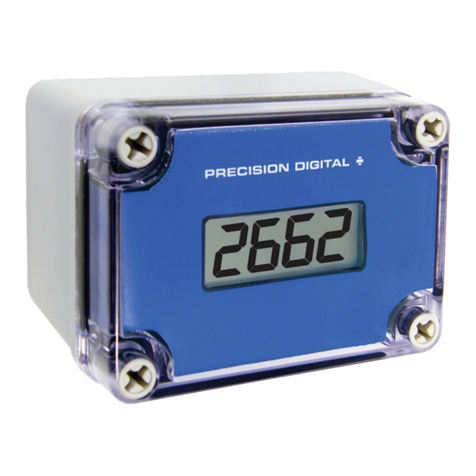
Precision Digital Corporation
Precision Digital Corporation Survivor PD662 quick start guide
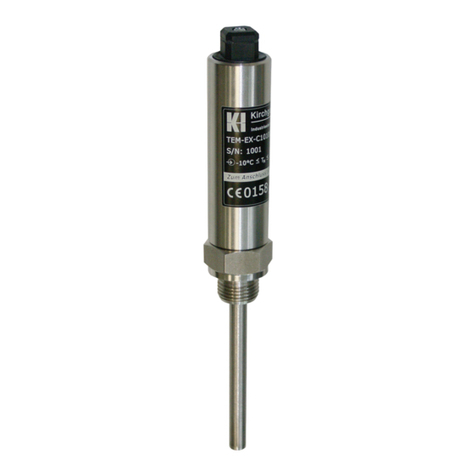
kirchgaesser
kirchgaesser TEM-EX-L operating instructions

mru
mru VARIOluxx user manual
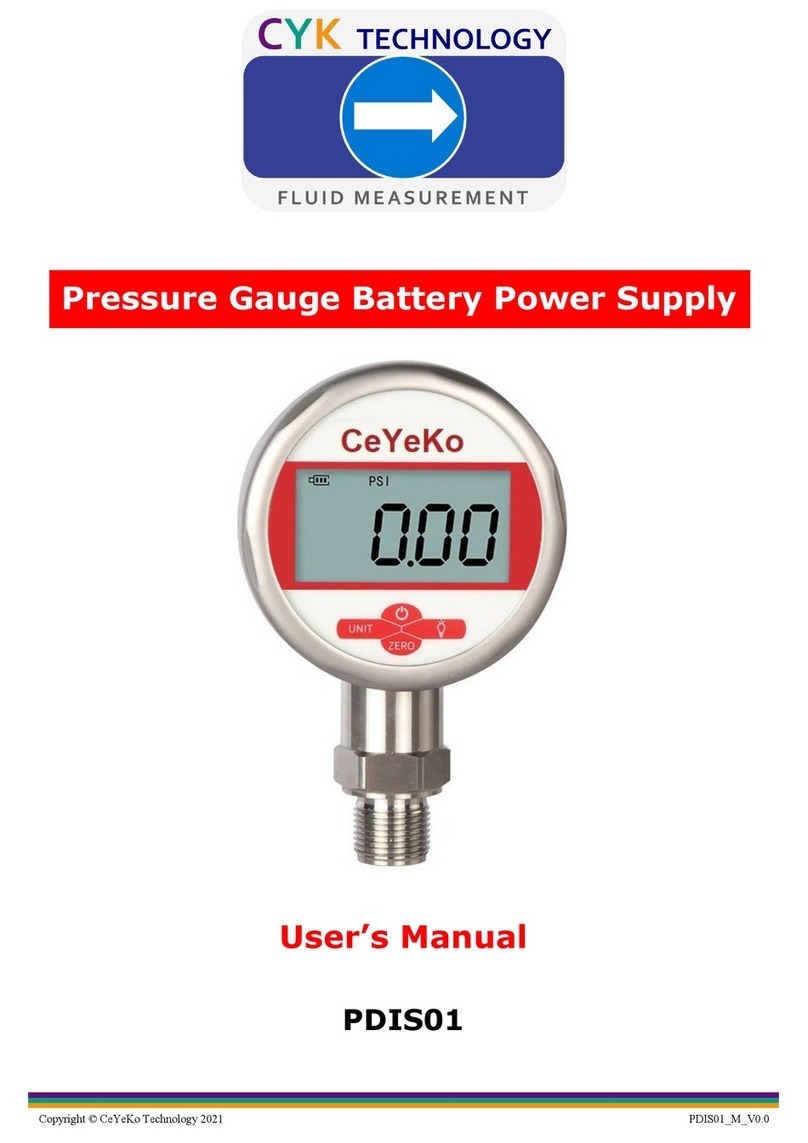
CeYeKo
CeYeKo PDIS01 user manual
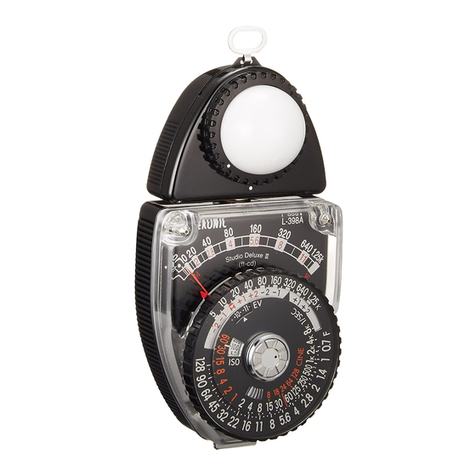
Sekonic
Sekonic STUDIO DELUXE? L-398A operating instructions
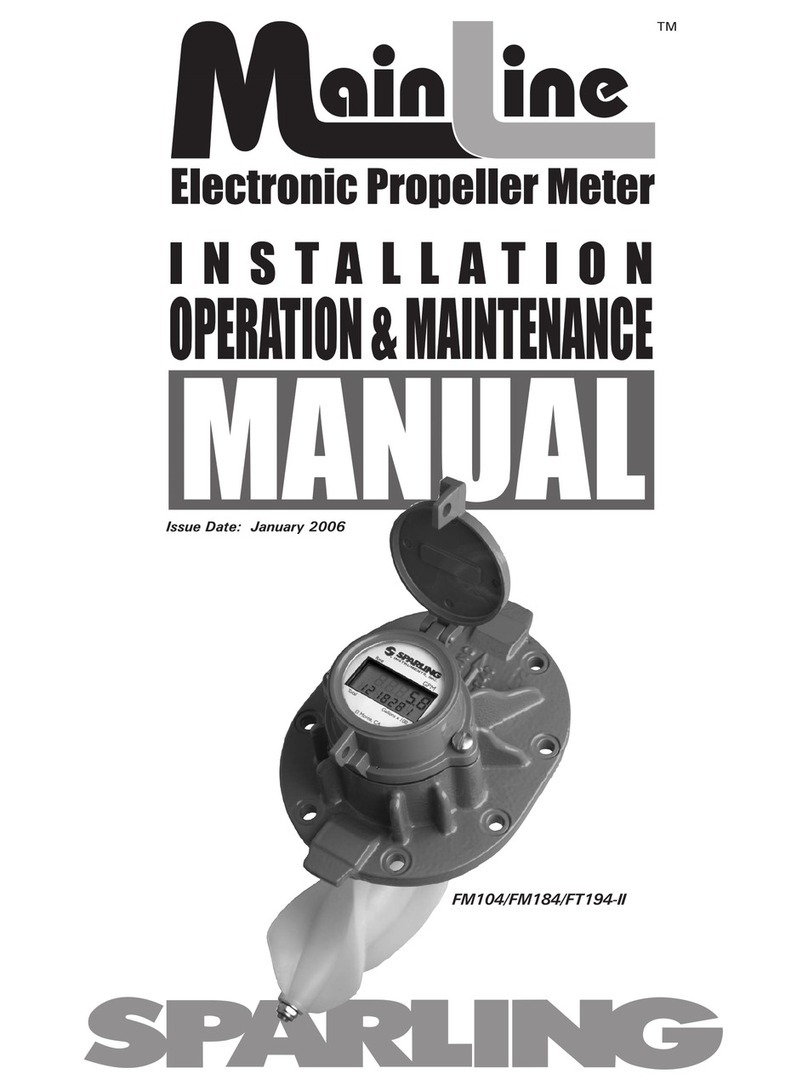
SPARLING
SPARLING MainLine FM-104 Installation, operaton & maintenance manual
